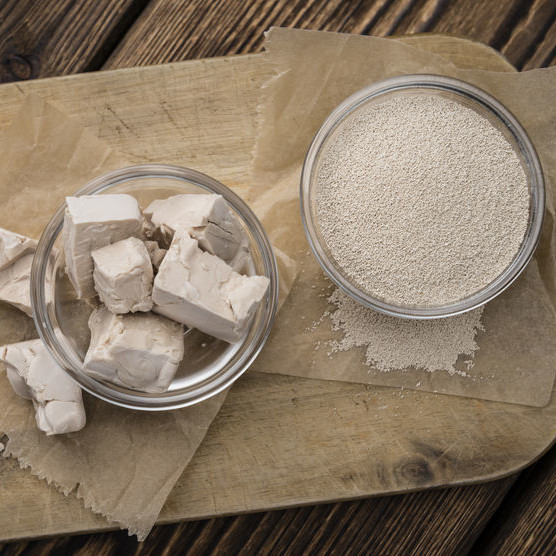
Yeast Spec Sheet
Also known as a technical product data sheet
What is a Yeast Spec Sheet?
A yeast spec sheet is a document that expresses and defines the requirements that must be met by yeast suppliers to comply with bakeries’ quality specifications and breadmaking processing conditions.
How does it work?
A yeast spec sheet should provide maximum, minimum and target values for each technical parameter related to yeast quality, storage and usage recommendations, and all relevant information that the bakery may need.1
Quality considerations for yeast
In case a bakery uses yeast that is “out-of-spec,” the dough may not process correctly and issues may arise during production. Excessively long fermentation and proofing times due to poor yeast vitality and viability, plus lack of yeast activity (gassing power) are common when using nonconforming yeast.
Low quality yeast usually presents high levels of cell death and damage and has a long lag phase, rendering it unusable in high-speed breadmaking operations. The end result is a bread which lacks flavor and aroma with poor volume.
Application
A yeast spec sheet should provide the following information:
- Product definition (e.g. compressed, liquid pumpable cream, dry)
- Comprehensive section. Information should include biomass production conditions (e.g. growth media used, nutrients added, production mode, drying process)
- Regulatory information (e.g. compliance with CFR Title 21 rules)
- Food safety information. Includes any information relevant to consumer safety.
- Kosher designation (if applicable).
- Organic designation (if applicable). A certifying agency and a certification date or code should be provided in this section.
- Non GMO and clean label designations (if applicable)
- Sampling plan for analysis. This section should describe:
- The procedure for obtaining yeast samples for analysis (in bulk or discrete amounts)
- Frequency of analysis (e.g., per shipment)
- Number of samples required
- Information as to how the samples are physically collected
- Acceptance criteria. This section should include:2,3
- Physical and organoleptic (e.g. consistency and friability in the case of compressed yeast, shape and size of particles for dried yeast, color and smell).
- Analytical specifications for quality parameters (e.g. dry matter, nitrogen, and phosphorus composition, residual carbohydrates)
- Microbiological specifications (morphology of yeast cells, budding rate). Attention should be given to identifying and counting foreign microflora.
- Maximum, minimum, target values and/or range of values for each technical parameter
- Testing procedures required for supplier analyses
- Specification of the approved methods for the analyses/test
- Procedure for dealing with out of spec data. This section should describe what action should be taken when an analysis is out of specification.
- Dosage recommendations. The following could be included:
- Amount in baker’s % to add according to breadmaking process or dough system used (e.g. 1% on sponge, 3% dough side).
- Maximum level of sugar in dough that yeast can handle for optimum baking performance (osmotic pressure tolerance).
- Minimum water levels in dough for optimum yeast activity.
- Recommendations regarding storage conditions. Yeast is a very sensitive microorganism and special care must be practiced during handling prior to use. Temperature, relative humidity, protection considerations against UV light and oxygen, and optimum storage time should be specified in this section.
- Shipping, packaging and shelf-life information. Accurate and relevant details on how the yeast is handled and transported to the bakery should be provided here. The following information may also be included:
- Packaging material mainly its barrier properties (e.g. gas permeability)
- Hygienic considerations when yeast is supplied in insulated tank trucks (e.g. cream yeast handled in bulk)
- Shelf-life of yeast according to recommended packaging and storage conditions (e.g. vacuum)
- Pallet configuration for shipments in bags (i.e. bags per pallet, bags per layer, gross weight per bag, pallet dimensions)
- Gassing power tests. Determined using valid methods to quantify carbon dioxide release from a dough with predetermined characteristics over a given time. This section may include results of gassing power tests such as:
- Risograph
- Fermentograph
- Maturograph
- Rheofermentometer
- Pressuremeter
In some cases where a bakery uses different yeast forms from the same yeast supplier (e.g. instant active dry yeast for making baguette and cream yeast for buns), the spec sheet should contain data and math steps to convert from one yeast form to another. Recommendations regarding handling and yeast preparation should also be provided.
| Yeast form | Conversion factor | % Moisture | % Solids | Recommendations |
| Compressed | 1.0 | 70 | 30 | Add directly to mixer |
| Cream | 1.6 | 85 | 15 | Pump directly to mixer |
| Active dry (ADY) | 0.5 | 5 | 95 | Must be pre-hydrated (activated) in warm water before use in dough (5–15 min) |
| Instant active dry (IDY) | 0.35 | 5 | 95 | No pre-hydrating step needed. Add directly to mixer |
References
- Nielsen, S.S. “Introduction to Food Analysis.” Food Analysis, 5th edition, Springer International Publishing, 2017, pp. 3–15.
- Poitrenaud, B. “Baker’s Yeast.” Handbook of Food and Beverage Fermentation Technology, Marcel Dekker, Inc., 2004, pp. 712–735.
- Athnasios, A.K., and Quantz, M. “Yeast.” Ullmann’s Food and Feed, volume 2, Wiley-VCH Verlag GmbH & Co., 2017, pp. 1014–1026.

